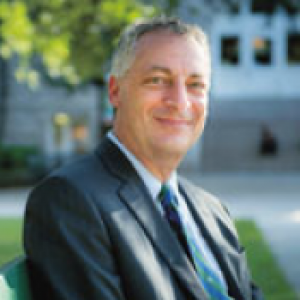Robin Forman
Senior Vice President for Academic Affairs and Provost, Professor of Mathematics

Areas of Expertise
Biography
Forman oversees all aspects of academic life at Tulane University and advises University President Michael Fitts on all academic matters. He works closely with the deans of the schools within Tulane and directors of the research centers and institutes in pursuit of the university's core missions in research, art-making, teaching, professional service and community engagement.
Forman was appointed Senior Vice President for Academic Affairs and Provost in September 2016. He previously served as dean of the Emory College of Arts and Sciences and the Asa Griggs Candler Professor of Mathematics at Emory University. He has held faculty and administrative appointments at Rice University, and has served as an instructor at MIT and as a visiting professor at the University of Burgundy, Harvard University and the Mathematical Research Institute.
Forman's research, which has been funded by the National Science Foundation, the National Security Agency and the Defense Advanced Research Projects Agency, focuses on combinatorial methods in topology and geometry.
Education
Harvard University
University of Pennsylvania
University of Pennsylvania
Articles
Modeling the precision and robustness of Hunchback border during Drosophila embryonic development
2008
During anterior-posterior axis specification in the Drosophila embryo, the Hunchback (Hb) protein forms a sharp boundary at the mid-point of the embryo with great positional precision. While Bicoid (Bcd) is a known upstream regulator for hb expression, there is evidence to suggest that Hb effectively filters out "noisy" data received from varied Bcd gradients. We use mathematical models to explore simple regulatory networks which filter out such noise to produce a precise Hb boundary. We find that in addition to Bcd and Hb, at least one freely evolving protein is necessary. An automated search yields a number of examples of three-protein networks exhibiting the desired precision. In all such networks, Hb diffuses much slower than the third protein. In addition, the action of Hb on the third protein is the opposite of the action of the third protein on hb (i.e. if Hb activates the third protein, then the third protein inhibits hb expression, and vice versa). Most of the discovered systems satisfy the known biological properties, that Bcd activates hb, and that Hb activates its own expression. We find that all network topologies satisfying these constraints arise among the networks exhibiting the desired precision. Investigating the dynamics of these networks, we find that under a general class of non-uniform initial conditions, Bcd can be eliminated from the system and the spatiotemporal evolution of these two proteins alone is sufficient to recapture the dynamics. We hypothesize that Bcd is needed only to spatially disturb the gradient of the third protein, and then becomes unnecessary in the further evolution of the Hb border. This provides a possible explanation as to why the Hb dynamics are robust under perturbations of the Bcd gradient. Under this hypothesis, other proteins would be able to assume the role of Bcd in our simulations (possibly in the case of evolutionary divergences or a redundancy in the process), with the only constraint that they act to positively regulate hb.
Finite-type invariants for graphs and graph reconstructions
2004
Many of the fundamental open problems in graph theory have the following general form: How much information does one need to know about a graph G in order to determine G uniquely. In this article we investigate a new approach to this sort of problem motivated by the notion of a finite-type invariant, recently introduced in the study of knots. We introduce the concepts of vertex-finite-type invariants of graphs, and edge-finite-type invariants of graphs, and show that these sets of functions have surprising algebraic properties. The study of these invariants is intimately related with the classical vertex- and edge-reconstruction conjectures, and we demonstrate that the algebraic properties of the finite-type invariants lead immediately to some of the fundamental results in graph reconstruction theory.
Bochner's Method for Cell Complexes and Combinatorial Ricci Curvature
2003
In this paper we present a new notion of curvature for cell complexes. For each p , we define a p th combinatorial curvature function, which assigns a number to each p -cell of the complex. The curvature of a p -cell depends only on the relationships between the cell and its neighbors. In the case that p=1 , the curvature function appears to play the role for cell complexes that Ricci curvature plays for Riemannian manifolds. We begin by deriving a combinatorial analogue of Bochner's theorems, which demonstrate that there are topological restrictions to a space having a cell decomposition with everywhere positive curvature. Much of the rest of this paper is devoted to comparing the properties of the combinatorial Ricci curvature with those of its Riemannian avatar.
Media Appearances
A Mathematician Deals With Another Complex System
Fifteen years ago, Robin Forman, Tulane University’s new chief academic officer, couldn’t have foreseen that he would devote his career to university administration. In fact, if someone had said so, "I would have been a bit insulted," he says.
Tulane Today Mentions
Tulane committees make recommendations on AI integration across campuses
Nationally renowned river ecologist named new director of ByWater Institute
Tulane University names renowned economist Gary Hoover as director of The Murphy Institute
Tulane receives $1 million to assist in fighting COVID-19
Three professors receive prestigious ACLS fellowships
School of Business extends New Orleans-style welcome
Barbara Moely service learning teaching award announced
Three Tulane researchers honored with national STEM award
Tulane’s ByWater Institute gets new leadership
‘Tulane 34’ grows by 34 graduates
